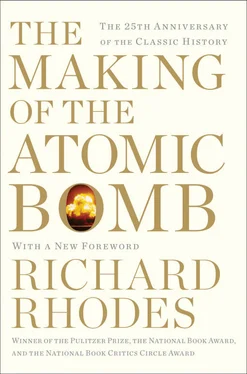The compensation for such emotional risk can be enormous. For the scientist, at exactly the moment of discovery—that most unstable existential moment—the external world, nature itself, deeply confirms his innermost fantastic convictions. Anchored abruptly in the world, Leviathan gasping on his hook, he is saved from extreme mental disorder by the most profound affirmation of the real.
Bohr especially understood this mechanism and had the courage to turn it around and use it as an instrument of assay. Otto Frisch remembers a discussion someone attempted to deflect by telling Bohr it made him giddy, to which Bohr responded: “But if anybody says he can think about quantum problems without getting giddy, that only shows that he has not understood the first thing about them.” 556Much later, Oppenheimer once told an audience, Bohr was listening to Pauli talking about a new theory on which he had recently been attacked. “And Bohr asked, at the end, ‘Is this really crazy enough? The quantum mechanics was really crazy.’ And Pauli said, ‘I hope so, but maybe not quite.’” 557Bohr’s understanding of how crazy discovery must be clarifies why Oppenheimer sometimes found himself unable to push alone into the raw original. To do so requires a sturdiness at the core of identity—even a brutality—that men as different as Niels Bohr and Ernest Lawrence had earned or been granted that he was unlucky enough to lack. It seems he was cut out for other work: for now, building that school of theoretical physics he had dreamed of.
* * *
On June 3, 1920, Ernest Rutherford delivered the Bakerian Lecture before the Royal Society of London. 558It was the second time he had been invited to fill the distinguished lectureship. He used the occasion to sum up present understanding of the “nuclear constitution” and to discuss his successful transmutation of the nitrogen atom reported the previous year, the usual backward glance of such formal public events. But unusually and presciently, he also chose to speculate about the possibility of a third major constituent of atoms besides electrons and protons. He spoke of “the possible existence of an atom of mass 1 which has zero nucleus charge.” Such an atomic structure, he thought, seemed by no means impossible. It would not be a new elementary particle, he supposed, but a combination of existing particles, an electron and a proton intimately united, forming a single neutral particle. 559
“Such an atom,” Rutherford went on with his usual perspicacity, “would have very novel properties. Its external [electrical] field would be practically zero, except very close to the nucleus, and in consequence it should be able to move freely through matter. Its presence would probably be difficult to detect by the spectroscope, and it may be impossible to contain it in a sealed vessel.” Those might be its peculiarities. This would be its exceptional use: “On the other hand, it should enter readily the structure of atoms, and may either unite with the nucleus or be disintegrated by its intense field.” A neutral particle, if such existed— a neutron —might be the most effective of all tools to probe the atomic nucleus.
Rutherford’s assistant James Chadwick attended this lecture and found cause for disagreement. 560Chadwick was then twenty-nine years old. He had trained at Manchester and followed Rutherford down to Cambridge. He had accomplished much already—as a young man, two of his colleagues write, his output “was hardly inferior to that of Moseley”—but he had sat out the Great War in a German internment camp, to the detriment of his health and to his everlasting boredom, and he was eager to move the new work of nuclear physics along. 561A neutral particle would be a wonder, but Chadwick thought Rutherford had deduced it from flimsy evidence.
That winter he discovered his mistake. Rutherford invited him to participate in the work of extending the nitrogen transmutation results to heavier elements. Chadwick had improved scintillation counting by developing a microscope that gathered more light and by tightening up procedures. He also knew chemistry and might help eliminate hydrogen as a possible contaminant, a challenge to the nitrogen results that still bothered Rutherford. “But also, I think,” said Chadwick many years later in a memoriallecture, “he wanted company to support the tedium of counting in the dark—and to lend an ear to his robust rendering of ‘Onward, Christian Soldiers.’” 562
“Before the experiments,” Chadwick once told an interviewer, “before we began to observe in these experiments, we had to accustom ourselves to the dark, to get our eyes adjusted, and we had a big box in the room in which we took refuge while Crowe, Rutherford’s personal assistant and technician, prepared the apparatus. 563That is to say, he brought the radioactive source down from the radium room, put it in the apparatus, evacuated it, or filled it with whatever, put the various sources in and made the arrangements that we’d agreed upon. And we sat in this dark room, dark box, for perhaps half an hour or so, and naturally, talked.” Among other things, they talked about Rutherford’s Bakerian Lecture. “And it was then that I realized that these observations which I suspected were quite wrong, and which proved to be wrong later on, had nothing whatever to do with his suggestion of the neutron, not really. He just hung the suggestion on to it. Because it had been in his mind for some considerable time.”
Most physicists had been content with the seemingly complete symmetry of two particles, the electron and the proton, one negative, one positive. Outside the atom—among the stripped, ionized matter beaming through a discharge tube, for example—two elementary atomic constituents might be enough. But Rutherford was concerned with how each element was assembled. “He had asked himself,” Chadwick continues, “and kept on asking himself, how the atoms were built up, how on earth were you going to get—the general idea being at that time that protons and electrons were the constituents of an atomic nucleus… how on earth were you going to build up a big nucleus with a large positive charge? And the answer was a neutral particle.”
From the lightest elements in the periodic table beyond hydrogen to the heaviest, atomic number—the nucleus’ electrical charge and a count of its protons—differed from atomic weight. Helium’s atomic number was 2 but its atomic weight was 4; nitrogen’s atomic number was 7 but its atomic weight was 14; and the disparity increased farther along: silver, 47 but 107; barium, 56 but 137; radium, 88 but 226; uranium, 92 but 235 or 238. Theory at the time proposed that the difference was made up by additional protons in the nucleus closely associated with nuclear electrons that neutralized them. But the nucleus had a definite maximum size, well established by experiment, and as elements increased in atomic number and atomic weight there appeared to be less and less room in their nuclei for all the extra electrons. The problem worsened with the development in the 1920s of quantum theory, which made it clear that confining particles as light as electrons so closely would require enormous energies, energies that ought to show up when the nucleus was disturbed but never did. The only evidence for the presence of electrons in the nucleus was its occasional ejection of beta particles, energetic electrons. That was something to go on, but given the other difficulties with packing electrons into the nucleus it was not enough.
“And so,” Chadwick concludes, “it was these conversations that convinced me that the neutron must exist. The only question was how the devil could one get evidence for it…. It was shortly after that I began to make experiments on the side when I could. [The Cavendish] was very busy, and left me little time, and occasionally Rutherford’s interest would revive, but only occasionally.” 564Chadwick would search for the neutron with Rutherford’s blessing, but the frustrating work of experiment was usually his alone.
Читать дальше












